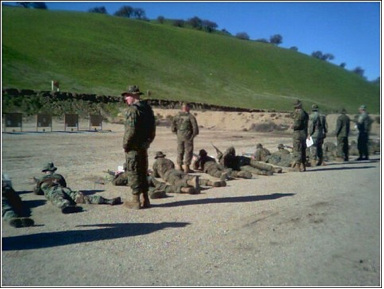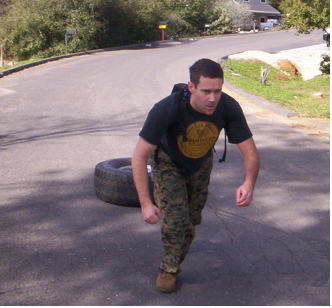It
Jordan Vezina, RKC
November 6, 2008 01:28 PM
In 1997 I had the privilege of taking an all expenses paid three-month vacation in sunny Southern California under the watchful eye of the Drill Instructors at Marine Corps Recruit Depot San Diego.
At 21 years old I stood 5'8" and weighed in at a whopping 114 lbs. I was small, and I was weak. The good news is that being so small meant I also had no endurance and could not run very fast. Fortunately my father had raised me on a steady diet of films such as 'They died with their boots on', 'March or die', and other various films with the word 'die' in the title. What I gleaned from this was that military men never quit, and you'll know you have reached your limits if you suddenly find that you are dead.
After boot camp the School of Infantry beckoned, where as one of the smallest in my squad I was of course designated as the SAW (squad automatic weapon) gunner. This is the height of training with odd objects, as it doesn't get much more odd than hauling a pack, full combat gear, and a SAW around the mountains of Camp Pendleton, where of course we run just about everywhere. If you are lucky you may even be saddled with a fifty caliber receiver or barrel, a mortar tube, or M240G machine gun, all of which I had the unique privilege of hauling around at one time or another.
What I did not realize at the time was that I was already filling a toolbox that I would return to again and again throughout my life. I was engaged in highly functional training that was going to prepare me for life in the Marine Corps Infantry.
Fast forward to 2nd F.A.S.T. (Fleet Anti-Terrorism Security Teams) Company in Yorktown, Virginia. If I thought that SOI had tested my limits, I was wrong. I crossed paths with SEAL Team 4 on a regular basis at the Dam Neck ranges and the Chesapeake Kill House and saw them a few times running around the base dragging tires behind them. Every team, squad, etc. needs at least one big bodybuilder guy to pull people out of holes, and there he was with an extra big tire tied to his waist. There was that tool-box again. Mental note: Running around dragging a tire is probably good.
Again and again I came across the big bodybuilder guys. Every once in a blue moon you met one who could actually perform (such as the one in SEAL Team 4), but for the most part they would try to scam out of unit PT, carry a bag of supplements out to the field, and do other things that were not preparing them properly for the coming storm. Once, one of these guys actually stood post with no rounds in his magazines because they made his gear too heavy. Seriously?
I saw this in Macedonia (south of the Kosovo border) as well. Marines were clinging desperately to their bodybuilding routines and supplements, trying not to lose weight. What they had lost site of was the fact that when everything hit the fan, the enemy was unlikely to engage them in a pose-down, or a bench-pressing contest, and would have no respect for how 'huge' they had been able to get. The only thing he is likely to understand goes by the designation 5.56, and you are unlikely to be able to accurately deliver that message if you are so exhausted dragging your bulk around that you can't see straight.

What makes this mentality worse, is that when a gym was unavailable, these types would simply stop working out. No bodyweight routines, no kettlebells, nothing. I began to realize even then that it wasn't just a matter of being physically unfit, but of creating a mentality that simply did not mesh with life as a combat soldier or marine.
I had taken my own endurance training seriously. I ran. I mean, I RAN, up to 30, 40, and on occasions 50 miles a week. I ran in PT gear, I ran in boots. I ran with a gas mask on. I wasn't even that fast, but I could keep going damn near indefinitely. I also ran my way straight into a jacked up right knee and a serious case of shin-splints. No problem, I'll just bind my calves with bandages and keep right on running. When it came to the humps (hikes under full load) I was still getting killed. What I didn't understand then was that while my endurance was great, my posterior chain was lacking. What strengthens the posterior chain?
Fast forward to kettlebell swings and snatches. In 2006 I attended a workshop with Jason C. Brown RKC Team Leader that re-filled my tool-box with kettlebells. My posterior chain became far stronger, and I developed glutes you can sit your beer on. More importantly, my instance of injury decreased to zero. Prior to this I was doing 'bodybuilding' style isolation training (albeit with some deadlifts and squats) and still staying on my healthy diet of running, though down to a manageable 15-20 miles a week. The problem was that I consistently had little tweaks and injuries. I now understand that this was due to training my body like a collection of parts, as opposed to one piece. The kettlebells changed that.
In the beginning I didn't get into anything fancy, because it just wasn't necessary. I would start off with some Turkish Get Ups, and then relentlessly bang out swings. Swing-swingety-swing-swing-swing, all day long. I would add in some high jumping, but that was pretty much it. I stopped running completely, because I just knew it wasn't necessary anymore aside from specificity reasons.
A series of errors in judgment landed me in the California National Guard. I was in the infantry? again. This time however things were different. The posterior chain was strong, my endurance was better than ever, and I was injury free. During the run portion of the APFT I smoked 90% of the battalion (most of whom were a decade younger than myself) despite the fact that I had barely run a mile in the past year.
The troop surge came, and I was ordered to Camp Roberts, CA. I went back into the toolbox and altered my program. A harness plus a tire equals 3 miles of fun. At least two days a week I would latch my tire on to my harness and drag it for about 3 miles. I figured out that it wasn't so much the weight of the tire, as the surface that dictated how difficult the drag was. The great thing about dragging a tire around is that you have to get it home; so quitting isn't really an option.

Down at Camp Roberts I was so physically dominant that it would have been funny but for the fact that we were engaged in a business where your life can depend upon your fitness level. Someone tried to make the case that I only had so much endurance because I was small, at which point I promptly picked up a 265-pound soldier and threw him over my shoulders. Now people started to listen more to what I was saying, and drink the kook-aid I was serving. It was also hard to ignore the fact that on the combat simulation courses while most of the soldiers were breathing fire and trying to avoid passing out from exhaustion, I was pulling off John Woo style shoulder rolls to make things more interesting.
I used my downtime at Camp Roberts and Fort Dix (of which there was quite a bit) to read through all of Pavel's books and start working on pistols and one-armed push-ups (
Naked Warrior for example). I had dropped a
sixteen kilogram kettlebell into my seabag and consistently worked on my swings, snatches, and Turkish Get Ups.
A torn tendon in my right hand ejected me from the surge and back to civilian life. Looking back I know that if I had been training my grip as much as I do now, that most likely would not have happened. Score another for functional training.
These days I carry around a toolbox packed full of heavy tools. The good news about carrying around such a heavy toolbox all the time is that it makes you stronger. The bad news is that you can be distracted by the many shiny tools and forget the well-worn wrench and hammer that built your foundation.
Program design in regard to true combat conditioning is not an equation that allows for guesswork, theory, or vanity. Developing a program for a baseball player or a mixed martial artist based upon a new theory you have, or to give him great abs, or because you think you understand the game may only result in fewer home runs hit, or the loss of a match. The consequences to the Soldier, Sailor, Airman, or Marine of a poorly conceived training program are much more dire.
I have often heard people say that it isn't that big a deal for the average Soldier or Marine to have tip top conditioning, as they aren't 'scaling walls' or doing 'spec-ops stuff'. This reveals a serious misunderstanding of what the Infantry Soldier and Marine go through day to day. Forget about jumping over walls and kicking down doors, something as seemingly passive as standing a twelve hour post wearing full combat gear in 120 degree heat while trying to stay alert is an endurance event that would put a marathon runner to shame.
The tactical athlete engages in a contest where fitness is not a luxury, but a necessity. PR's will be counted in enemy dead, and second place is rewarded with a flag draped coffin. We know that kettlebell training and other functional training methods are what prepare our professional warriors most effectively for the field, much more efficiently than bodybuilding or other vanity based programs. A decade from now changes that are currently being seeded throughout the military will reflect this truth.
Make sure that you are part of the solution, not part of the problem.
Jordan Vezina RKC, CFT trains out of Girya in Palo Alto, CA with Mark Reifkind Master RKC. Jordan is a five year Marine Corps Infantry Veteran, former Bodyguard, and writer. Jordan is available for individual training and workshops. His e-mail is Jordan@averagetoelite.com
Jordan's website is http://www.averagetoelite.com
Back